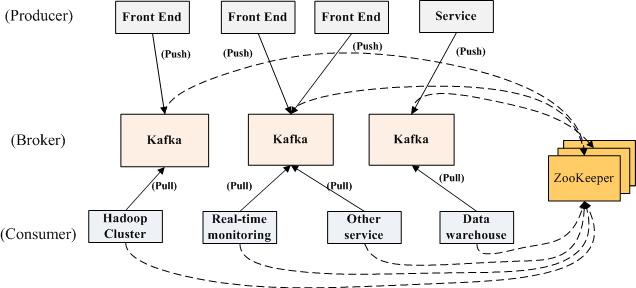最新:Apache Kafka is a community distributed streaming platform capable of handling trillions of events a day. Initially conceived as a messaging queue, Kafka is based on an abstraction of a distributed commit log. Since being created and open sourced by LinkedIn in 2011, Kafka has quickly evolved from messaging queue to a full-fledged streaming platform.
Kafka最初被设想为消息传递队列,它基于分布式提交日志的抽象。 自2011年由LinkedIn创建并开源以来,Kafka已迅速从消息队列发展成为一个成熟的流媒体平台。
Kafka是由LinkedIn开发的一个分布式的发布-订阅的消息系统,它以可水平扩展和高吞吐率而被广泛使用。目前越来越多的开源分布式处理系统如Cloudera、Apache Storm、Spark都支持与Kafka集成。
Kafka用途广泛,可以用作消息队列。在实际应用中被大量的用于日志系统。
转载:https://my.oschina.net/ielts0909/blog/92972
Apache Kafka® is a distributed streaming platform.
A streaming platform has three key capabilities:
- Publish and subscribe to streams of records, similar to a message queue or enterprise messaging system.
- Store streams of records in a fault-tolerant durable way.
- Process streams of records as they occur.
Kafka is generally used for two broad classes of applications:
- Building real-time streaming data pipelines that reliably get data between systems or applications
- Building real-time streaming applications that transform or react to the streams of data
首先我们要明白什么是消息系统,在kafka官网上对kafka的定义叫:A distributed publish-subscribe messaging system。publish-subscribe是发布和订阅的意思,所以更准确的说kafka是一个消息订阅和发布的系统。publish-subscribe这个概念很重要,因为kafka的设计理念就可以从这里说起。
我们将消息的发布(publish)暂时称作producer,将消息的订阅(subscribe)表述为consumer,将中间的存储阵列称作broker,这样我们就可以大致描绘出这样一个场面:

生产者(蓝色,蓝领么,总是辛苦点儿)将数据生产出来,丢给broker进行存储,消费者需要消费数据了,就从broker中去拿出数据来,然后完成一系列对数据的处理。
乍一看这也太简单了,不是说了它是分布式么,难道把producer、broker和consumer放在三台不同的机器上就算是分布式了么。我们看kafka官方给出的图:

多个broker协同合作,producer和consumer部署在各个业务逻辑中被频繁的调用,三者通过zookeeper管理协调请求和转发。这样一个高性能的分布式消息发布与订阅系统就完成了。图上有个细节需要注意,producer到broker的过程是push,也就是有数据就推送到broker,而consumer到broker的过程是pull,是通过consumer主动去拉数据的,而不是broker把数据主动发送到consumer端的。
这样一个系统到底在哪里体现出了它的高性能,我们看官网上的描述:
- Persistent messaging with O(1) disk structures that provide constant time performance even with many TB of stored messages.
- High-throughput: even with very modest hardware Kafka can support hundreds of thousands of messages per second.
- Explicit support for partitioning messages over Kafka servers and distributing consumption over a cluster of consumer machines while maintaining per-partition ordering semantics.
- Support for parallel data load into Hadoop.
至于为什么会有O(1)这样的效率,为什么能有很高的吞吐量我们在后面的文章中都会讲述,今天我们主要关注的还是kafka的设计理念。了解完了性能,我们来看下kafka到底能用来做什么,除了我开始的时候提到的之外,我们看看kafka已经实际在跑的,用在哪些方面:
- LinkedIn - Apache Kafka is used at LinkedIn for activity stream data and operational metrics. This powers various products like LinkedIn Newsfeed, LinkedIn Today in addition to our offline analytics systems like Hadoop.
- Tumblr - http://highscalability.com/blog/2012/2/13/tumblr-architecture-15-billion-page-views-a-month-and-harder.html
- Mate1.com Inc. - Apache kafka is used at Mate1 as our main event bus that powers our news and activity feeds, automated review systems, and will soon power real time notifications and log distribution.
- Tagged - Apache Kafka drives our new pub sub system which delivers real-time events for users in our latest game - Deckadence. It will soon be used in a host of new use cases including group chat and back end stats and log collection.
- Boundary - Apache Kafka aggregates high-flow message streams into a unified distributed pubsub service, brokering the data for other internal systems as part of Boundary's real-time network analytics infrastructure.
- DataSift - Apache Kafka is used at DataSift as a collector of monitoring events and to track user's consumption of data streams in real time. http://highscalability.com/blog/2011/11/29/datasift-architecture-realtime-datamining-at-120000-tweets-p.html
- Wooga - We use Kafka to aggregate and process tracking data from all our facebook games (which are hosted at various providers) in a central location.
- AddThis - Apache Kafka is used at AddThis to collect events generated by our data network and broker that data to our analytics clusters and real-time web analytics platform.
- Urban Airship - At Urban Airship we use Kafka to buffer incoming data points from mobile devices for processing by our analytics infrastructure.
- Metamarkets - We use Kafka to collect realtime event data from clients, as well as our own internal service metrics, that feed our interactive analytics dashboards.
- SocialTwist - We use Kafka internally as part of our reliable email queueing system.
- Countandra - We use a hierarchical distributed counting engine, uses Kafka as a primary speedy interface as well as routing events for cascading counting
- FlyHajj.com - We use Kafka to collect all metrics and events generated by the users of the website.
至此你应该对kafka是一个什么样的系统有所体会,并能了解他的基本结构,还有就是他能用来做什么。那么接下来,我们再回到producer、consumer、broker以及zookeeper这四者的关系中来。

我们看上面的图,我们把broker的数量减少,只有一台。现在假设我们按照上图进行部署:
l Server-1 broker其实就是kafka的server,因为producer和consumer都要去连它。Broker主要还是做存储用。
l Server-2是zookeeper的server端,zookeeper的具体作用你可以去官网查,在这里你可以先想象,它维持了一张表,记录了各个节点的IP、端口等信息(以后还会讲到,它里面还存了kafka的相关信息)。
l Server-3、4、5他们的共同之处就是都配置了zkClient,更明确的说,就是运行前必须配置zookeeper的地址,道理也很简单,这之间的连接都是需要zookeeper来进行分发的。
l Server-1和Server-2的关系,他们可以放在一台机器上,也可以分开放,zookeeper也可以配集群。目的是防止某一台挂了。
简单说下整个系统运行的顺序:
1. 启动zookeeper的server
2. 启动kafka的server
3. Producer如果生产了数据,会先通过zookeeper找到broker,然后将数据存放进broker
4. Consumer如果要消费数据,会先通过zookeeper找对应的broker,然后消费。
参考资料:
kafka系列文章索引:https://my.oschina.net/ielts0909/blog/117489
kafka学习总结:https://my.oschina.net/u/1475616/blog/374686
分布式消息系统Kafka初步:https://my.oschina.net/ielts0909/blog/92972
Kafka背景及架构介绍:http://www.infoq.com/cn/articles/kafka-analysis-part-1/